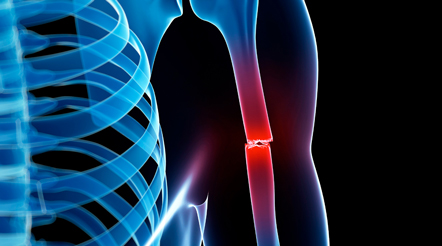
President’s Letter
2023 Metrics
Cycle of Translation
Visionary Gifts

Discovery to Clinic

Innovative Education

Translational Luminaries
Introduction
Jerold B. Katz Academy of Translational Research
Infectious Diseases Research Fund
Houston Methodist Dr. Mary and Ron Neal Cancer Center
Ann Kimball and John W. Johnson Center for Cellular Therapeutics at Houston Methodist
The Food & Health Alliance within the Houston Methodist Lynda K. and David M. Underwood Center for Digestive Disorders, Immunology Center and the Fondren Inflammation Collaborative
Houston Methodist Cockrell Center for Advanced Therapeutics
Paula and Joseph C. “Rusty” Walter III
Translational Research Initiative
COVID-19 Studies
Outcomes Research
Restorative Medicine
Houston Methodist Advances Research into Neural Prosthetics
Noninvasive Spinal Stimulation Works to Restore Movement After Spinal Cord Injury
An Innovative Approach to Treat Even the Most Stubborn-to-Heal Fractures
Cell Encapsulation May Hold the Key to Preventing Cell Transplant Rejection
Houston Methodist, Rice University, Baylor College of Medicine Design Noninvasive Tech to Help Remove Brain’s Metabolic Waste
Houston Methodist Investigators Nanotechnology Investigators Awarded Prestigious Grants from the Department of Defense
Precision Medicine
Cancer Cell Type (Seed) and Tumor Microenvironment (Soil) Control Therapeutic Antibody Delivery and Efficacy
Novel Drug Combination Can Target Triple-Negative Breast Cancer for Treatment
A Houston Methodist and Purdue University Breakthrough May Result in a More Effective Tuberculosis Vaccine
Importance of the Coronary Artery Calcium Score in Risk Assessment and Prevention of Atherosclerotic Cardiovascular Disease
New Virtual Intensive Care Unit Simultaneously Improves Patient Care and Bed Capacity
result
Introduction
Joint Weill Cornell–Houston Methodist Academic Institute Doctoral Program Welcomes its Inaugural Class
Visionary EnMed Program Soars to New Heights
Neural Control of Organ Degeneration and Regeneration (NeuralCODR) Training Program
Faculty and Research Development
Graduate Medical Education



Science in Service
of
Medicineresult
President's letter
2021 Metrics
Cycle of Translation
Visionary Gifts of Hope


Introduction

Ann Kimball and John W. Johnson Center for Cellular Therapeutics at Houston Methodist

Houston Methodist Dr. Mary and Ron Neal Cancer Center

The Food & Health Alliance within the Houston Methodist Lynda K. and David M. Underwood Center for Digestive Disorders, Immunology Center and the Fondren Inflammation Collaborative

Houston Methodist Cockrell Center for Advanced Therapeutics

Paula and Joseph C. “Rusty” Walter III Translational Research Initiative

Jerold B. Katz Academy of Translational Research

Infectious Diseases Research Fund

From Discovery to Clinic


What is "Discovery to Clinic"?

Restorative Medicine


Houston Methodist Advances Research into Neural Prosthetics

Noninvasive Spinal Stimulation Works to Restore Movement After Spinal Cord Injury

An Innovative Approach to Treat Even the Most Stubborn-to-Heal Fractures

Cell Encapsulation May Hold the Key to Preventing Cell Transplant Rejection

Houston Methodist, Rice University, Baylor College of Medicine Design Noninvasive Tech to Help Remove Brain’s Metabolic Waste

Houston Methodist Investigators Nanotechnology Investigators Awarded Prestigious Grants from the Department of Defense

Precision Medicine


Cancer Cell Type (Seed) and Tumor Microenvironment (Soil) Control Therapeutic Antibody Delivery and Efficacy

New Virtual Intensive Care Unit Simultaneously Improves Patient Care and Bed Capacity

Novel Drug Combination Can Target Triple-Negative Breast Cancer for Treatment

A Houston Methodist and Purdue University Breakthrough May Result in a More Effective Tuberculosis Vaccine

Importance of the Coronary Artery Calcium Score in Risk Assessment and Prevention of Atherosclerotic Cardiovascular Disease

Translational Luminaries




Discovery to Clinic

Outcomes Research
Houston Methodist-Developed Algorithm May Improve Management and Outcomes in Critically Ill COVID-19 Patients
Houston Methodist-Developed Algorithm May Improve Management and Outcomes in Critically Ill COVID-19 Patients

In the United States, physical therapy (PT) is commonly administered to patients in the intensive care unit (ICU) since these patients suffer from weakness, fatigue and poor functional status. Physical therapists play a fundamental role in improving the quality of life of ICU patients during their recovery from critical illnesses. The COVID-19 surge between March and May 2020 in Houston caused several cardiovascular, neurological and musculoskeletal symptoms in patients. Patients with COVID-19 in the ICU suffered from these symptoms and were at risk for reduced functional mobility, reduced quality of life, increased mortality and increased risk for developing post-intensive care syndrome and ICU-acquired weakness.

Catherine Stolboushkin PT, DPT, CCS
At the beginning of the pandemic, PT intervention appeared to be limited in the ICU and primarily focused on proning, range of motion and bed exercises. After discussions with clinicians in other hospitals, review of the literature and patient observation, Catherine Stolboushkin, PT, DPT, CCS, at the Houston Methodist Rehabilitation Services noticed that the ICU patients with COVID-19 could endure more intensive PT intervention than anticipated. However, some of these patients were outside the normal parameters for initiating PT intervention and continuing mobility exercises, which presented a unique clinical challenge. This suggested the need for better clinical decision-making processes to provide safe and effective PT intervention at the bedside to ICU patients.
To describe the PT practice in critically ill patients with COVID-19 at a tertiary care hospital such as Houston Methodist and to outline a novel clinical decision-making algorithm (nCDM) and its applications in improving clinical practice for this patient population, Stolboushkin performed a retrospective chart review, the results of which were published in the Cardiopulmonary Physical Therapy Journal in 2021. This study entailed selection and evaluation of PT and demographic data and clinical records of patients with COVID-19 admitted to Houston Methodist Hospital ICUs with a PT consultation between March and May 2020.
According to Stolboushkin, “Physical therapy intervention is an integral component of a patient’s course for recovery during and after critical illness due to COVID-19. This algorithm allowed us to provide PT intervention for patients who may not have been seen or for whom intervention may have been delayed based on our previous guidelines. Further research needs to be done on the safety and feasibility of using this clinical decision-making algorithm for patients with COVID-19 or other similar respiratory impairments.”
The COVID-19 surge challenged health care professionals to adjust best practices and become creative. This retrospective chart review was the first to describe PT practice for critically ill patients with COVID-19 in the ICU, with or without mechanical ventilation. The clinical decision-making algorithm described here can be applied to diseases other than COVID-19, such as acute respiratory distress syndrome being treated in ICU settings. Moreover, this study pushed the envelope with the patient tolerance and mobility of PT intervention.Taken together, the novel algorithm developed by Stolboushkin can help clinicians identify patient populations suitable for PT intervention as well as the optimum time of PT intervention to maximize the safety and quality of life of ICU patients with COVID-19.












